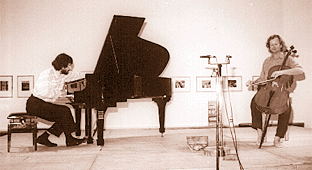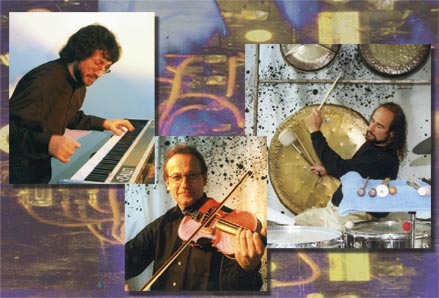Bürck - Graeter Duo
Bürck - Graeter-Casserley Trio

Roland Graeter, cello/voice
Lawrence Casserley, live electronics
In the autumn 1995 Rainer Bürck, composer and pianist specializing in contemporary repertoire, and Roland Graeter, specializing in improvised music, decided to form a duo, trying to build bridges from their different backgrounds between contemporary "composed" and improvised music. When Rainer Bürck met composer Lawrence Casserley in the summer of 1996 the idea was born to transform the duo into a trio with Casserley processing the sounds of the piano, cello and voice with the help of his IRCAM signal-processing work-station. Rehearsals aimed less at the creation of particular musical material than at the process of reacting to, and communicating with each other, aiming to let the unexpected and unpredictable happen and trying to avoid cliches.
T R I O N Y S

Martin Bürck, Gongs, Percussion & Elektronik
Günter Marx, Violine & Elektronik
TRIONYS worked out an overall dramatic form which is defined by characteristic sound regions, performing actions and interactions between the musicians. It is an open form which allows the musicians to branch out into different musical textures at any time and even to include other existing pieces. Besides parts which are exactly determined, there is also room for spontaneous and exciting improvisation.
The roots of TRIONYS go back to the late seventies when Rainer Bürck (keyboards), Martin Bürck (percussion) and Rolf Wenisch (bass guitar) explored the boundaries between experimental rock music / art rock and experimental contemporary music. After concerts between 1980 and 1982 the musicians pursued their individual musical careers.
In the summer of 1998 Rainer and Martin Bürck developed plans for a renewed artistic collaboration. Though their aesthetic aims had changed in the course of time, they still felt obliged to the same pioneering spirit: to the spirit of creating exciting, risky and forward-looking music. Therefore they decided to name this new project TRIONYS again. They could win Günter Marx as a congenial and dedicated partner.
The electronic sounds are based on sounds which had been sampled (and partly electronically processed) from the particular instruments. The actions of the musicians are transformed into MIDI data via MIDI controllers. Each musician's MIDI data is then processed in a seperate computer via a MIDI Processing Program developed by Rainer Bürck before controlling a sampler. This program provides a vast variety of processing procedures, enabling the musicians to trigger complex sound textures.